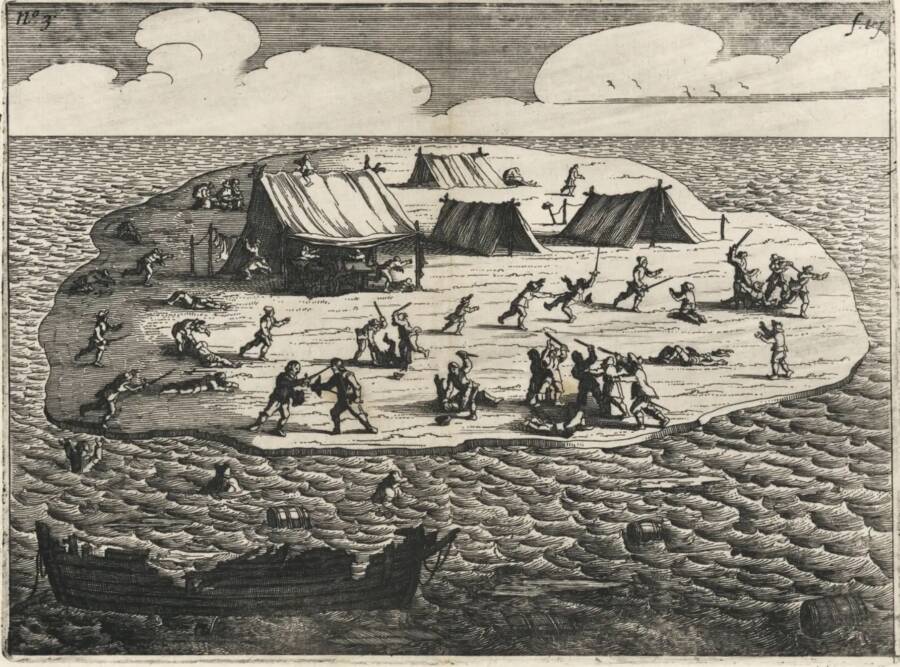After the Dutch merchant ship Batavia wrecked near Australia in 1629, a mutiny prompted an all-out war that eventually left some 200 people dead.
On October 29, 1628, the Dutch East India Company launched the Batavia, a state-of-the-art merchant ship unlike anything the world had ever seen before.
The ship was laden with silver coins and carried somewhere between 320 and 340 passengers bound for the city of Batavia in present-day Indonesia, which was both the ship’s namesake and the administrative and commercial hub of the Dutch East Indies. The city of Batavia had been generating significant wealth for the Dutch, thanks to the spice trade as well as other commodities like coffee, tea, and sugar.
The ship Batavia was meant to travel to the city to obtain spices and bring them back to the Netherlands — but unfortunately, it never completed its maiden voyage.
During the journey, violent storms caused the Batavia to separate from the rest of its fleet, and suddenly it was forced to cross the Indian Ocean alone. Then, on June 4, 1629, the Batavia struck Morning Reef in the Houtman Abrolhos archipelago off the western coast of Australia. Roughly 300 survivors managed to reach the nearby islands, but they now found themselves in a barren landscape with limited resources.
Recognizing the dire nature of the situation, the ship’s commander Francisco Pelsaert took a longboat with 48 men, including his skipper Ariaen Jacobsz, on a 1,864-mile journey to Batavia to seek rescue.
In his absence, Pelsaert left a senior official from the Dutch East India Company, Jeronimus Cornelisz, in charge. Unbeknownst to Pelsaert, however, Cornelisz had been planning a mutiny for months — and he now had the perfect opportunity to act on his plans.
Cornelisz quickly dispatched a group of soldiers under the command of Wiebbe Hayes to search for fresh water on nearby islands. However, it was only a ruse, and his actual intention was to abandon the men and leave them to certain doom. With any potential opposition then removed, Cornelisz and his followers began to execute one of the bloodiest mutinies in history.

Australian National Maritime MuseumAn artist’s illustration of the Batavia mutiny.
Over the next several weeks, they murdered nearly 125 members of the crew, including men, women, and children, with the goal of reducing the group’s numbers enough to conserve resources and eliminate any threats to Cornelisz’s authority.
Many of the women, he kept as sex slaves – including one named Lucretia Jans, who he reserved for himself.
What Cornelisz did not know, however, was that Hayes and his men had actually managed to find fresh water and food sources on the island to which they’d been sent. And when they learned of Cornelisz’s atrocities, they waged several battles against him and his mutineers — the last and bloodiest of which took place in October 1629, the same month Pelsaert returned with the rescue ship Sardam.
Pelsaert arrived to find the two factions at war, the remainder of the crew split between the mutineers and Hayes’ loyalists. He conducted swift trials, leading to the execution of Cornelisz and six of his accomplices.
As further punishment, both of Cornelisz’s hands were cut off before he was hanged. Two lesser offenders, meanwhile, were marooned on the Australian mainland, making them the first Europeans to reside there, though their fates remain unknown to this day.
In the end, only 122 of the original passengers and crew of the Batavia made it to port. The other 200 were victims, in one way or another, of one of the most harrowing shipwrecks and disturbing mutinies in recorded history.
Learn more about the music used in our podcast. History Uncovered is part of the Airwave Media network. Learn more about your ad choices by visiting megaphone.fm/adchoices.






